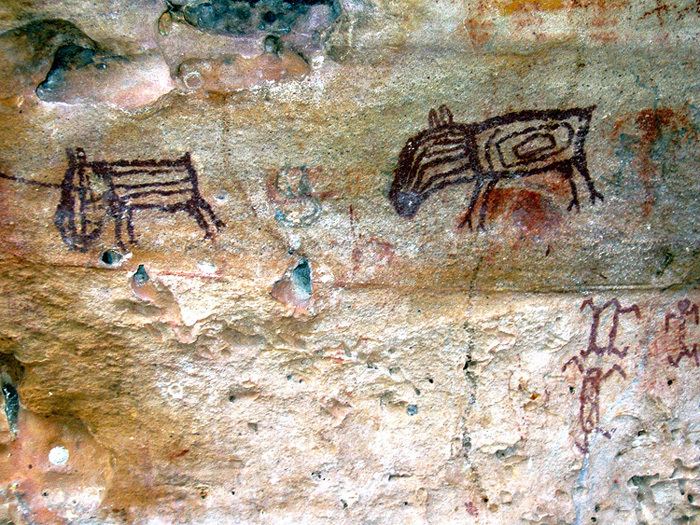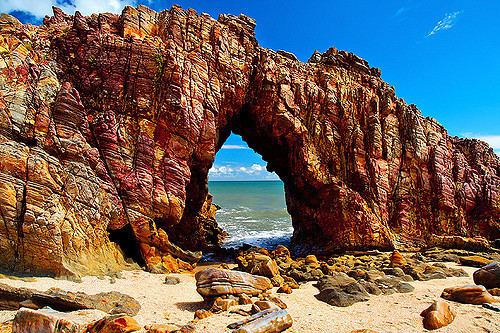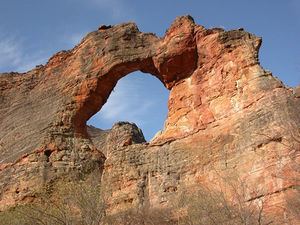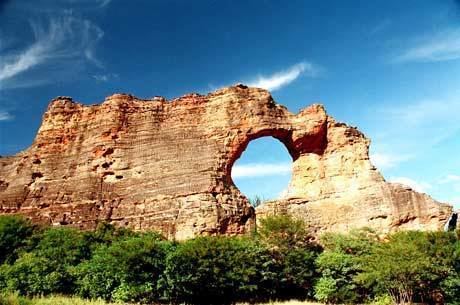Pedra furada jericoacoara ce
Pedra Furada ([ˈpɛdɾɐ fuˈɾadɐ], meaning pierced rock) is an important collection of over 800 archaeological sites in the state of Piauí, Brazil. These included hundreds of rock paintings dating from circa 11,000 years ago. Charcoal from very ancient fires and stone shards that may be interpreted as tools suggest the possibility of a human presence prior to the arrival of Clovis people in North America.
Contents
- Pedra furada jericoacoara ce
- Morro da igreja e pedra furada
- Excavations
- Significance
- Controversy
- References

In 1973, a Brazilian and French team excavating a site located in the southeastern portion of what is now the Serra da Capivara National Park discovered the first finds. The discovery was reported by the Brazilian archaeologist Niède Guidon, who published her findings in 1986. She has since conducted extensive excavations and published other findings.

Morro da igreja e pedra furada
Excavations

Pedra Furada includes a collection of rock shelters used for thousands of years by human populations. The first excavations yielded charcoal deposits with Carbon-14 dates of 48,000 to 32,000 years BP. Repeated analysis has confirmed this dating, carrying the range of dates up to 60,000 BP. A review of the site by archaeologist Tom Dillehay in 1994 suggested that the charcoal remains may have been from natural fires and were not necessarily indicative of human occupation.

Guidon has established 15 distinct levels, classified in three cultural phases, called Pedra Furada, that includes the oldest remains; and Serra Talhada, from 12,000 to 7,000 BP, with tools such as knives, scrapers, flakes used "as is" or with some retouch and lithic cores, all made of quartz or quartzite. Third is Agreste late phase. The site also has hundreds of rock paintings dated from 5,000 to 11,000 years ago.

More recently, the site of Toca da Tira Peia, also in Serra da Capivara National Park, was shown to have signs of human presence dating to 22,000 years ago.

Also the nearby site of Sitio do Meio has been excavated over the years. Although not as old, in some ways it helps to support and clarify the chronology of Pedra Furada. The lithics at Sitio do Meio are better preserved.
Significance
The discoveries are the subject of debate as they apparently contradict the longstanding "Clovis first" view for the settlement of humans in the Americas, which holds that the first inhabitants of the continent were representatives of the Clovis culture, which began roughly 11,500 BP. Discoveries at other sites, such as Monte Verde, Chile, dated to 14,800 years BP, Piedra Museo in the Argentinian province of Santa Cruz, dated 11,000 years BP, Topper in the state of South Carolina, U.S.A. dated 16,000–20,000 years BP, and the Meadowcroft Rockshelter located near Avella in Washington County in southwestern Pennsylvania, United States, dated to 16,000 years BP, have also raised doubts about the "Clovis First" theory. As a result, scholars have proposed alternate scenarios for the routes of colonization and the diffusion of culture through the continents, in a heated dispute that has not been resolved.
The mainstream view of the peopling of the Americas, also known as the short chronology theory, is that the first movement beyond Alaska into the New World occurred no earlier than 15,000 – 17,000 years ago, followed by successive waves of immigrants. Pedra Furada provides potential evidence for the proponents of the long chronology theory, which states that the first group of people entered the hemisphere at a much earlier date, possibly 21,000–40,000 years ago, with a much later mass secondary wave of immigrants. This evidence is considered controversial and not widely accepted by experts in the field.
Controversy
Debate continues as to whether or not the artifacts and hearths are instead geofacts that were made naturally. This seems to be a dividing line on the debate among archaeologists disputing Guidon's theory that the site's artifacts prove pre-Clovis human settlement in the Americas. The controversy has been characterized by Alex Bellos, at The Guardian, as "U.S." archaeologists believing that the items are geofacts created naturally, "because the North Americans cannot believe that they do not have the oldest site", while David Meltzer, of the Southern Methodist University in Dallas asks "...if we have (pre-Clovis) humans in South America, then by golly, why don't we have them in North America too?"
Guidon has said that "The carbon is not from a natural fire. It is only found inside the sites. You don't get natural fires inside the shelters" and adding that "The problem is that the Americans criticize without knowing. The problem is not mine. The problem is theirs. Americans should excavate more and write less". French palaeolithic archaeologist Jacques Pelegrin, believes there is a possibility for natural processes creating flaked stones that could mimic the Pedra Furada specimens because of their simplicity, but he finds this very unlikely in this case because of continuous human presence in the site.
